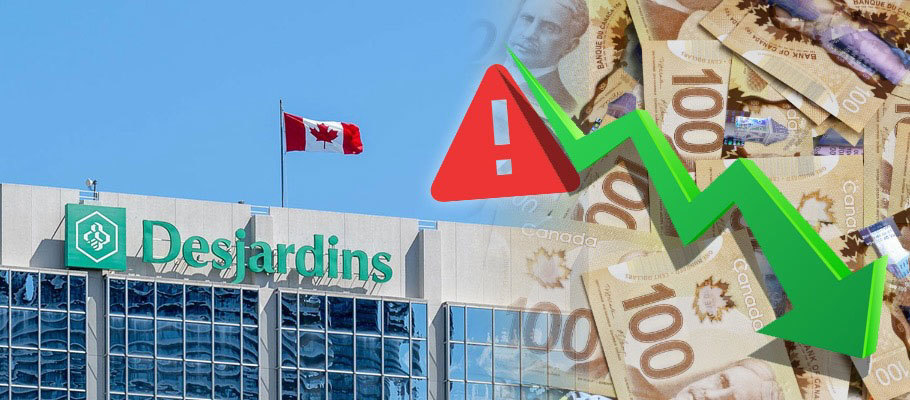
Published: July 6th, 2022
Analysts at Montreal-based Desjardins Bank say the Canadian Dollar is headed for steady declines during the second half of 2022.
In a mid-year currency market analysis, economists at Desjardins' FX Strategy Unit expect the global economic outlook to be challenging over the coming months, a backdrop which will work against the Commodity-sensitive Loonie. Rising interest rates from the Bank of Canada (BoC) will add to the headwinds by pressurizing Canadian households already laden with credit card debt.
‘Global recession worries are already impacting the Canadian dollar, which isn't normally seen as a safe haven during times of upheaval. Markets are still disrupted, and risk-appetite remains weak across the board, though there have been occasional spikes of optimism.’
Investors are also expecting the BoC in Ottawa to lift interest rates by nearly 200 basis points over the next six months as policy makers look to cool rising inflation and try to work in parallel with the US Federal Reserve.
‘Markets are looking for interest rate rises in Canada to be at the high end, though not high enough to nudge CAD’s value upward. Hiking interest rates could also aggravate Canada’s high levels of household debt and even cause a significant correction in the residential housing market.’
If Desjardins is right, it will mean a stark reversal for CAD. As the second half of 2022 kicks off, the Loonie remains the second-best performing currency of 2022 amongst G10 majors, trailing just behind the outperforming greenback.
Gains this year have been driven by a blend of strong post-COVID economic growth, rising oil prices, and a strong demand from Canada’s biggest trading partner south of the 49th Parallel.
Despite all that, Desjardins thinks CAD is set to depreciate in the coming quarters. 'Our forecast is based on declining commodity prices, a cooling Canadian economy, and a likely correction in prices for residential real estate of around 15 per cent.’
Those factors combined mean the Bank of Canada may have to reduce its monetary tightening faster in the Autumn.
Desjardins sees the Sterling to Canadian Dollar exchange rate reaching 1.5712 by the end of the Q3 and 1.5865 by year’s end. It could come back to 1.6079 by the end of the Q3 2023.
For the Greenback to Canadian Dollar exchange rate Desjardins is targeting 1.2985 by the end of Q3 and 1.3331 by years' end. By the end of Q1 2023, the banks is targeting 1.3513.
The Euro to Canadian Dollar exchange rate is forecast at 1.3505 by the end of Q3 and 1.3731 by year’s end. By the end of the first quarter of 2023 its expected to hit and 1.3784.
While 2H 2022 has been good for Loonie bulls, it hasn't all been plain sailing. At the end of May CAD was headed toward the bottom of the G10 league table, having been outperformed by all but mighty USD. In fact, it started June just ahead of the Mexican Peso, which topped the G20 list.
Drifting CAD performance helped the Pound to Canadian Dollar exchange rate stay north of the 1.60 level for the most of this week’s session and might free the pair to recover ground lost recently if it can sustain that handle through the coming weeks.
In a research briefing at the time, RBC Capital Markets’ FX Strategy Unit said that the top cash rate had fallen by close to 20bps over consecutive sessions, and blamed ‘spillover’ from US market sentiment for the trend.
The impact was ‘symmetrical,’ RBC noted, as US trends can send Canadian cash rates higher or lower.
RBC lso said that market expectations for the Bank of Canada’s (BoC) top cash rate dropped in late May in sympathy with their American equivalents.
That was significant since Canadian economic data had been minimal in recent weeks. It wouldn’t have been the first time CAD found itself tossed about on changing expectations for Federal Reserve (Fed) policy or changes in US economic conditions.
'The spillover effect into Canada from US bond yields could explain the stark differences between economic forecasts driven by domestic fundamentals, and market expectations that consider US Treasury spillover plus other asset prices as well,’ RBC added.
In the same timescale, American government bond yields fell while debt prices swung back in what has been an unsettled stretch for global stock markets. Some of CAD’s late-Q2 price action came on the heels of indicators pointing to slowing US economic growth.
In perhaps the first warning the CAD might face a bumpy ride in 2H 2022, RBC analysts said that in core capital goods categories such as defense and aerospace, growth in April was 0.3 per cent. That was below consensus expectations of 0.5 per cent growth.
There were also signals that at least some US Fed policymakers were ready to adapt their views on how rapidly US interest rates would have to rise in order to keep inflation under wraps in the second half of 2022. That factor is now impacting Desjardins’ 2H 2022 outlook.
It could mean more US bond yield spillover that would affect borrowing costs for Canadian households, with possible implications for BoC rate policy, Canadian economic growth, and Loonie valuations.
‘Markets are currently pricing in consecutive 50bps rate hikes from the Bank of Canada after its June and July meetings. Though we are largely aligned with investor expectations for these next two BoC meetings, after that our forecasts diverge,’ Desjardins wrote in its market analysis.
'Investors see more rate hike sin the pipeline, with 2022 ending at 2.75 per cent. Based on our analysis, we believe the pace of interest rate policy delivery will slow down in the Autumn.’ Ultimately, says Desjardins, the Bank of Canada won't not be able to extend beyond the neutral rate, which is currently forecast to settle at 2.5 per cent.